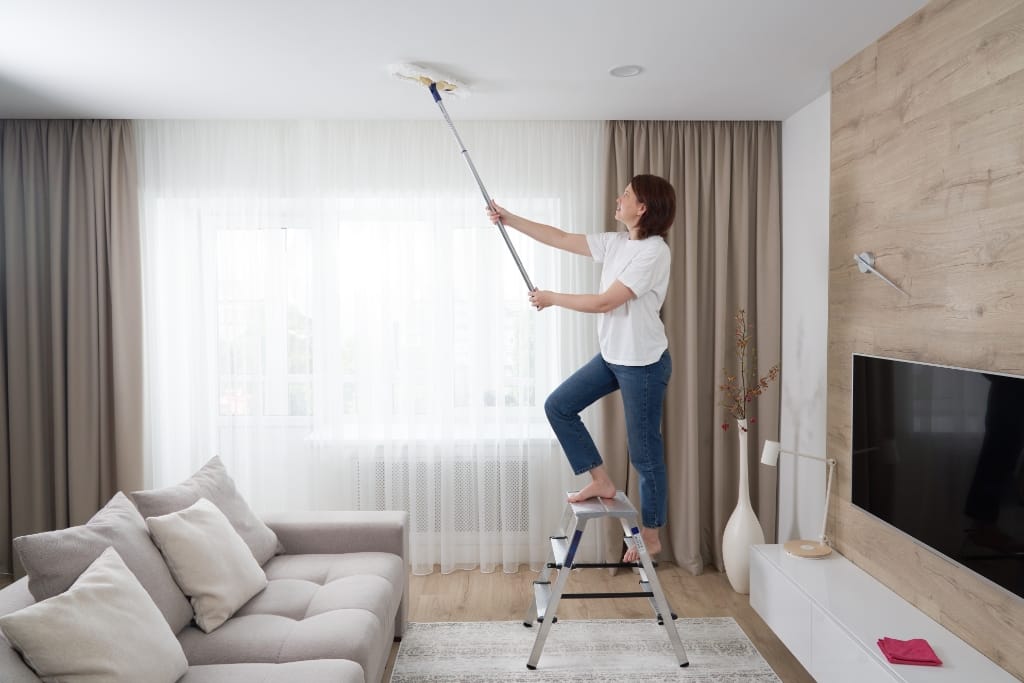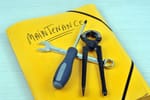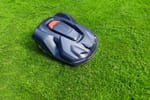Keeping your high ceilings free of cobwebs maintains a pristine appearance and contributes to a healthier living environment.
This guide will walk you through the essential steps and techniques for effectively removing cobwebs from hard-to-reach areas.
You can ensure a thorough cleaning process by utilizing the right tools and following important safety precautions.
Whether you're preparing for a special event or conducting routine home maintenance, this comprehensive guide will equip you with the knowledge and skills needed to tackle cobwebs efficiently and prevent them from returning.
Cleaning high ceilings is vital for maintaining a healthy and attractive home environment.
Cobwebs, along with dust and other debris, can accumulate over time, potentially leading to respiratory issues and allergies.
Cobwebs can give your living spaces an unkempt appearance, detracting from the overall aesthetic of your home.
Keeping your high ceilings clean not only improves indoor air quality but also helps to prevent the spread of dust mites and other allergens.
Moreover, regular maintenance of these often-overlooked areas can enhance the longevity of paintwork and fixtures, ensuring your interiors remain in optimal condition.
To effectively remove cobwebs from high ceilings, having the right tools and materials is crucial.
You'll need an extendable duster or broom to reach those lofty heights without straining yourself.
A sturdy ladder or scaffolding is also essential for safely accessing areas that are out of arm's reach; ensure it's stable and secure before you climb.
Safety gear such as gloves and goggles will protect your hands and eyes from dust and debris.
A vacuum cleaner with an extendable hose can be highly effective for stubborn cobwebs and ensures that dust doesn't simply relocate to another part of your home.
Finally, it's helpful to have a damp cloth handy for wiping down surfaces where cobwebs tend to cling persistently.
With these tools and materials, you can tackle high-ceiling cobwebs efficiently and safely.
Ensuring safety while cleaning high ceilings is paramount to prevent accidents and injuries.
First and foremost, always use a sturdy ladder or scaffolding that is designed for the heights you need to reach, and make sure it is set up correctly on a flat, stable surface.
It's advisable to have a spotter or assistant to hold the ladder and provide additional support.
Wearing gloves and goggles can protect your skin and eyes from dust, debris, and any chemical residue if you use cleaning agents.
Avoid overreaching or leaning too far from your support as this can cause a loss of balance.
If possible, opt for extendable tools to reduce the need for climbing altogether.
Prioritize your safety by taking these precautions seriously to ensure a smooth and accident-free cleaning process.
Step 1: Prepare Your Space
Preparing your space is the first crucial step in effectively and safely tackling cobwebs on high ceilings.
Proper preparation ensures that the cleaning process will be smooth and efficient while minimizing potential hazards.
Start by clearing the area of any furniture or obstacles that could impede your movement or cause accidents.
By laying down protective coverings, you can safeguard your floors and furniture from dust and debris.
Equally important is gathering all necessary tools and materials before you begin, such as an extendable duster, ladder, and safety gear.
A thorough inspection of the ceiling for cobwebs and other debris will help you identify the key areas to focus on.
Taking these initial steps will set the stage for a successful and safe cobweb removal process.
Clear The Area
Move Furniture And Other Obstacles
Moving furniture and other obstacles is an essential step to ensure a safe and efficient cleaning process for high ceilings.
Begin by relocating any furniture, such as tables, chairs, and lamps, to create ample space for maneuvering ladders or scaffolding.
This will help prevent accidental damage to your belongings and reduce the risk of tripping or falling.
Clear away smaller items like rugs, decorative pieces, and other household objects that could pose hazards or become cluttered with dust and debris.
Taking the time to create a wide, unobstructed workspace not only improves your accessibility to the high ceilings but also streamlines the entire cleaning process, making it easier and safer to reach cobwebs and other debris.
Lay Down Protective Coverings
Laying down protective coverings is a vital step in the preparation process for cleaning high ceilings.
These coverings shield your floors and furniture from dust, debris, and possible cleaning agent spills, ensuring they remain clean and undamaged.
Use sturdy plastic sheeting or drop cloths to cover large areas effectively, securing them with tape to prevent any movement during the cleaning process.
If you're working in a carpeted area, ensure that the edges of the coverings are tightly sealed to prevent dust from seeping through.
By carefully deploying protective coverings, you create a safer and more efficient workspace, mitigating the need for additional cleaning and protecting the integrity of your home’s interior elements.
Gather Your Tools
Extendable Duster Or Broom
An extendable duster or broom is an indispensable tool for cleaning high ceilings, allowing you to reach elevated areas without the need for a ladder or scaffolding.
These tools typically feature telescoping handles that can be adjusted to the desired length, providing flexibility and ease of use.
The duster head is often made from materials like microfiber or feathers, which are excellent for trapping and holding onto dust and cobwebs without scattering them.
Some models even come with pivoting heads to help you clean at various angles and get into hard-to-reach corners.
Using an extendable duster or broom not only makes the cleaning process more efficient but also enhances safety by reducing the need to climb and balance on tall ladders.
Ladder Or Scaffolding
Using a ladder or scaffolding is often necessary when cleaning high ceilings, as these tools provide the stability and reach required for effective cleaning.
A sturdy, well-maintained ladder is essential and should be chosen based on the height needed, ensuring it extends at least three feet above the working area for added safety.
When setting up a ladder, make certain it is placed on a flat, stable surface and locked securely to prevent any movement.
Scaffolding, on the other hand, offers a more extensive work platform, allowing for greater mobility and storage of tools while you work.
When erecting scaffolding, follow all manufacturer instructions and safety guidelines, verifying that all components are properly assembled and secured.
Always use guardrails and wear a safety harness if the scaffolding is particularly high.
By carefully selecting and correctly utilizing a ladder or scaffolding, you can accomplish your cleaning tasks efficiently while minimizing the risk of falls and injuries.
Safety Gear
When cleaning high ceilings, safety gear such as gloves, goggles, and other protective equipment is essential to protect yourself from dust, debris, and potential chemical exposure.
Gloves safeguard your hands from harsh cleaning agents and prevent skin irritation while offering a better grip on tools and ladders.
Goggles shield your eyes from dust particles and any splashes from cleaning solutions, reducing the risk of eye injuries.
Consider wearing a dust mask to protect your respiratory system from inhaling fine particles that can be released into the air during the cleaning process.
Proper footwear with non-slip soles is also crucial to maintaining stability and preventing slips or falls.
By equipping yourself with the appropriate safety gear, you can prioritize your well-being and work more effectively while tackling high-ceiling cleaning tasks.
Inspect The Ceiling
Identify Cobweb Locations
Identifying cobweb locations is a critical step in the process of cleaning high ceilings, as it allows you to systematically target and remove these unsightly webs.
Begin by thoroughly scanning the entire ceiling area, paying special attention to corners, light fixtures, and areas around vents where cobwebs are more likely to accumulate.
Utilizing a flashlight can help illuminate darker areas and reveal any hidden webs.
It's also helpful to look for telltale signs of spider activity, such as the presence of small insects caught in the cobwebs, which can indicate active webs.
By carefully identifying all cobweb locations beforehand, you ensure a more comprehensive and efficient cleaning process, leaving your ceilings spotless and free from spider webs.
Check For Other Debris Or Dust
Checking for other debris or dust is a fundamental step in ensuring that your high ceilings are thoroughly cleaned.
After identifying cobwebs, inspect the entire ceiling for additional dust accumulation or any other forms of debris.
This includes looking at the surface of ceiling fans, light fixtures, beams, and decorations that may also gather dust over time.
Use a bright light to reveal any hidden dust particles that might not be visible in regular room lighting.
Besides dust, look out for any stains, spots, or marks that might require specific cleaning solutions.
By being meticulous in this inspection, you guarantee that every part of the ceiling is addressed, resulting in a cleaner, healthier environment within your home.
Step 2: Remove The Cobwebs
After meticulously identifying the locations of cobwebs on your high ceilings, the next step is to effectively remove them.
This task not only improves the appearance of your space but also helps to maintain a cleaner and healthier environment.
Removing cobwebs requires the right tools and techniques to ensure they are completely eradicated without causing damage to your ceiling or spreading dust and debris.
Whether you use an extendable duster, broom, or vacuum with an extension wand, careful execution is key to making sure those unsightly cobwebs are thoroughly cleared away.
Let's delve into the specific methods and precautions needed to accomplish this task efficiently.
Use The Extendable Duster
Extend The Tool To Reach High Areas
Using an extendable duster to reach high areas is an effective and practical approach to cleaning high ceilings without the need for ladders or scaffolding.
Extendable dusters have long, adjustable handles that allow you to extend the tool to the necessary length, making it easier to access ceiling corners, light fixtures, and other hard-to-reach spots.
To use the tool effectively, begin by adjusting the handle to the required length, ensuring it's securely locked in place to prevent any unexpected retraction.
Move the duster gently across the ceiling surface in smooth, even strokes to capture dust, cobwebs, and other debris.
Because these tools often include microfiber heads or disposable dusting pads, they effectively trap and hold particles, reducing the likelihood of dust falling onto lower surfaces.
By extending the tool to reach high areas, you can clean efficiently while maintaining safety and minimizing the physical strain typically associated with climbing and stretching.
Gently Swipe To Remove Cobwebs
When using an extendable duster to remove cobwebs, it is important to gently swipe rather than aggressively scrub.
Begin by positioning the duster at the edge of a cobweb and slowly moving it across the web in a smooth, controlled motion.
This technique ensures that the web is caught by the duster's fibers and effectively removed without spreading dust and debris into the air.
Be mindful of applying just enough pressure to detach the cobweb without damaging delicate surfaces or causing the cobweb to disintegrate, which can create more of a mess.
By gently swiping to remove cobwebs, you maintain the integrity of your cleaning tool, avoid scratching or scuffing your ceiling, and achieve a cleaner, more orderly living space.
Use A Ladder Or Scaffolding
Set Up Ladder/Scaffolding Securely
Setting up a ladder or scaffolding securely is crucial for ensuring safety while cleaning high ceilings.
Begin by choosing a ladder or scaffolding that is appropriate for the height you need to reach and that is in good condition.
Place the ladder on a flat, stable surface to prevent it from tipping over. If you're using a ladder, make sure to fully extend and lock any extension mechanisms, and angle the ladder correctly—about one foot away from the wall for every four feet of ladder height.
For scaffolding, ensure that all pieces are properly assembled and locked in place and that the platform is level.
Always use safety features such as guardrails or harnesses if available.
Double-check the stability of the setup before climbing, and never overreach while on the ladder or scaffold; move it as needed to maintain a safe position.
By taking these precautions, you can greatly reduce the risk of accidents and confidently perform your cleaning tasks.
Climb Carefully And Remove Cobwebs By Hand If Necessary
Climbing carefully and removing cobwebs by hand, if necessary, is often the best approach for tackling stubborn or hard-to-reach webs.
Begin by ensuring you have a stable and secure footing before ascending the ladder or scaffolding.
As you climb, maintain three points of contact — either two hands and one foot or two feet and one hand — to enhance stability.
Once you're at the appropriate height, use a gloved hand or a soft cloth to gently grasp and pull away the cobwebs.
This hands-on method allows for greater precision and control, ensuring that you can reach intricate spots that tools might miss, such as tight corners and behind fixtures.
Always move slowly and deliberately to avoid losing balance, and watch for any unexpected obstacles or changes in surface texture.
By taking your time and using a cautious approach, you ensure both your safety and a thorough cleaning job.
Address Stubborn Cobwebs
Use A Damp Cloth For Persistent Webs
Using a damp cloth for persistent webs can be an effective way to ensure that even the most stubborn cobwebs are thoroughly removed.
Start by lightly moistening a soft, clean cloth with water; avoid soaking it, as excess moisture can damage your ceiling or walls.
Carefully climb your ladder or scaffolding with the damp cloth in hand, ensuring you have a secure and stable position.
Gently press the cloth against the cobweb, allowing the moisture to loosen the web's grip, and then slowly wipe it away in a smooth, controlled motion.
The slight dampness helps to capture and hold the web rather than just pushing it around, making it easier to clean without spreading dust or debris.
This method is particularly useful for webs that have adhered to surfaces or are in tricky areas that are not easily reached with a duster.
Remember to frequently rinse and wring out the cloth to avoid redepositing grime back onto the cleaned areas.
Employ A Vacuum With An Extendable Hose
Employing a vacuum with an extendable hose is a highly efficient method for removing cobwebs from high ceilings and hard-to-reach areas.
This approach combines the reach and precision of an extendable tool with the powerful suction capabilities of a vacuum, ensuring that cobwebs, dust, and debris are effectively captured and contained.
Begin by selecting a vacuum with a hose attachment that can be extended to the desired length.
Securely set up your ladder or scaffolding if needed, and position the vacuum hose near the cobweb.
Activate the vacuum and gently maneuver the hose around the cobweb, allowing the suction to pull it into the vacuum without dispersing particles into the air.
This method not only enhances the thoroughness of your cleaning efforts but also minimizes the risk of allergens and dust settling on lower surfaces.
Regularly check the vacuum filter and empty the dust container to maintain optimal performance.
By employing a vacuum with an extendable hose, you achieve a more efficient and cleaner result with minimal physical strain.
Step 3: Prevent Future Cobwebs
Preventing future cobwebs is essential to maintaining a clean and welcoming living environment.
While it's inevitable that some spiders will find their way indoors, there are proactive steps you can take to minimize their presence and, consequently, the formation of cobwebs.
In this section, we'll explore effective strategies for discouraging spiders from setting up residence in your home.
By implementing these preventative measures, you not only reduce the frequency of cobweb removal but also create a more hygienic and comfortable space for you and your family.
Regular Cleaning Routine
Schedule Routine Cobweb Checks
Scheduling routine cobweb checks is a proactive measure that significantly contributes to a spider-free home.
Set a reminder to inspect high corners, ceiling areas, and other less-frequented spaces for cobwebs on a weekly or bi-weekly basis.
By integrating these checks into your regular cleaning routine, you can quickly identify and remove any newly formed webs before they become more extensive problems.
Consistent monitoring not only keeps your home looking cleaner but also disrupts the spiders' life cycle, reducing the likelihood of them returning.
Regular attention to this task helps to maintain an inviting and well-maintained living environment, mitigating the chance of spiders settling in your home.
Integrate High Ceiling Cleaning Into Regular Cleaning Habits
Integrating high-ceiling cleaning into your regular cleaning habits is crucial for maintaining a spotless and cobweb-free home.
High ceilings, often overlooked in daily cleaning routines, can accumulate dust, cobwebs, and other debris over time, detracting from the overall cleanliness of your space.
By including these areas in your regular cleaning schedule, you ensure a more comprehensive approach to home maintenance.
Use extended-reach tools such as long-handled dusters or vacuum attachments to effortlessly tackle these high spots without the need for ladders or scaffolding.
Regular attention to high ceilings not only enhances the aesthetic appeal of your home but also prevents the build-up of allergens and improves indoor air quality.
By making high ceiling cleaning a habitual part of your cleaning regimen, you create a cleaner, healthier, and more inviting living environment.
Seal Entry Points
Check For Cracks Or Openings
Inspecting your home for cracks or openings is a fundamental step in preventing spiders from entering and creating cobwebs.
Begin by conducting a thorough examination of both the interior and exterior of your home, paying close attention to areas around windows, doors, and the foundation.
Look for any small gaps, cracks, or holes where spiders and other insects could gain entry.
Seal these potential entry points using appropriate materials such as caulk for small cracks or expanding foam for larger openings.
Regularly check and maintain these seals, especially in older homes where materials may have degraded over time.
By diligently addressing these structural vulnerabilities, you reduce the likelihood of spiders finding their way inside, thereby minimizing the formation of cobwebs and contributing to a cleaner, more pest-free living environment.
Seal Them To Prevent Spiders From Entering
Sealing entry points to prevent spiders from entering is an effective method for maintaining a cobweb-free home.
After identifying cracks, gaps, and openings, it is vital to properly seal these vulnerabilities using appropriate sealing materials.
For smaller cracks and gaps around windows and doors, use a high-quality silicone caulk to create a durable barrier.
For larger openings or gaps in the foundation, apply expanding foam, which can fill substantial spaces and create a robust seal.
Ensure that any damaged screens on windows and vents are promptly repaired or replaced to block entry points.
Door sweeps can also be installed at the bottom of external doors to eliminate any gaps.
Regularly monitor these sealed areas to ensure that the seals remain intact and perform any necessary maintenance.
By effectively sealing these entry points, you significantly reduce the likelihood of spiders entering your home, thereby minimizing the occurrence of cobwebs and maintaining a cleaner, more comfortable living environment.
Use Deterrents
Apply Natural Spider Repellents
Applying natural spider repellents is a safe and eco-friendly approach to deter spiders from entering your home.
Essential oils such as peppermint, tea tree, eucalyptus, and lavender are known to be effective in repelling spiders due to their strong scents.
To create a natural spider repellent, mix a few drops of one or more of these essential oils with water in a spray bottle and generously spritz areas where spiders are likely to enter or dwell, such as doorways, windowsills, and baseboards.
Placing dried eucalyptus leaves or sachets filled with lavender in closets, cabinets, and other secluded spots can help to keep spiders at bay.
Regularly reapply these natural repellents, especially after cleaning or once the scent begins to fade.
By utilizing these non-toxic, natural solutions, you can maintain a spider-free home without the need for harsh chemicals, creating a safer environment for you, your family, and your pets.
Consider Using Essential Oils Known To Repel Spiders
Essential oils are not only pleasant to the senses but also serve as effective deterrents against spiders in your home.
Oils such as peppermint, tea tree, eucalyptus, and rosemary are particularly known for their spider-repelling properties.
To employ them, simply add a few drops of your chosen essential oil to a spray bottle filled with water, and apply the mixture to areas where spiders are likely to enter or hide.
This includes window frames, door gaps, corners, and behind furniture. Reapply the solution regularly, especially after cleaning, to maintain its effectiveness.
Consider placing cotton balls soaked in essential oils in strategic locations around your home.
Using essential oils is a natural, non-toxic way to keep spiders at bay while also infusing your living space with a pleasing aroma.
This method is especially beneficial for households with children and pets, as it avoids the use of harsh chemicals.
Conclusion
Maintaining cobweb-free high ceilings is crucial for several reasons.
Firstly, it significantly enhances the overall aesthetic appeal of your home, creating a clean, polished look that is inviting and pleasing to the eye.
Removing cobwebs also plays a vital role in improving indoor air quality, as it eliminates potential allergen sources that could affect the health of your household members.
Furthermore, regular cleaning of high ceilings prevents the build-up of dust and spider webs, which can contribute to a fresher and more hygienic living environment.
By making high ceiling maintenance a regular part of your cleaning routine, you promote a healthier, more comfortable home and reduce the chances of spiders establishing their presence indoors.
When addressing the task of spider prevention and cobweb maintenance, it is important to prioritize safety.
Always use a sturdy ladder or step stool when reaching high ceilings to prevent falls and injuries.
Make sure the area around you is clear of obstacles, and consider having someone assist you by holding the ladder.
When applying natural repellents or sealing cracks, wear gloves and protective eyewear to avoid direct contact with chemicals or irritants.
For those with respiratory sensitivities, wearing a mask can help reduce the inhalation of dust or strong scents from essential oils.
Finally, ensure proper ventilation while using sprays or sealants to avoid inhaling fumes.
By following these safety precautions, you can effectively manage cobwebs and spider prevention without compromising your well-being.
Following a regular cleaning schedule is essential for maintaining a clean, healthy, and pleasant living environment.
Consistent cleaning not only helps to prevent the accumulation of dust, dirt, and allergens but also discourages pests such as spiders from making your home their own.
By routinely addressing key areas like high ceilings, corners, and hidden spaces, you reduce the likelihood of cobweb formation and ensure that your home remains tidy and welcoming.
A structured cleaning regimen can also alleviate the stress associated with sporadic, deep-cleaning sessions, making home maintenance more manageable and less time-consuming.
Implementing a regular cleaning schedule fosters a sense of order and discipline, ultimately contributing to a more comfortable and hygienic living space for you and your family.
Download Our Free E-book!







